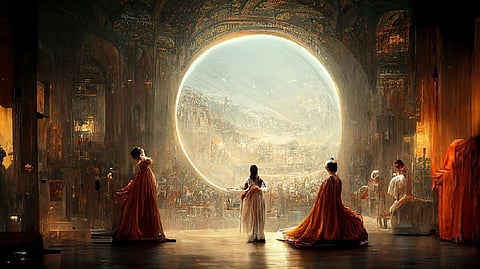

This year, the Colorado State Fair’s annual art competition gave out prizes in all the usual categories: painting, quilting, sculpture. But one entrant, Jason M. Allen of Pueblo West, Colo., didn’t make his entry with a brush or a lump of clay. He created it with Midjourney, an artificial intelligence program that turns lines of text into hyper-realistic graphics. Allen’s work, “Theatre D’opéra Spatial,” took home the blue ribbon in the fair’s contest for emerging digital artists — making it one of the first AI-generated pieces to win such a prize, and setting off a fierce backlash from artists who accused him of, essentially, cheating.
Allen defended his work. He said that he had made clear that his work — which was submitted under the name “Jason M. Allen via Midjourney” — was created using AI, and that he hadn’t deceived anyone about its origins. “I’m not going to apologise for it,” he said. “I won, and I didn’t break any rules.” AI-generated art has been around for years. But tools released this year — with names like DALL-E 2, Midjourney and Stable Diffusion — have made it possible for rank amateurs to create complex, abstract or photo-realistic works simply by typing a few words into a text box.
These apps have made many human artists understandably nervous about their own futures — why would anyone pay for art, they wonder, when they could generate it themselves? They have also generated fierce debates about the ethics of AI-generated art, and opposition from people who claim that these apps are essentially a high-tech form of plagiarism.
Allen, 39, began experimenting with AI-generated art this year. He runs a studio, Incarnate Games, which makes tabletop games, and he was curious how the new breed of AI image generators would compare with the human artists whose works he commissioned.
This summer, he got invited to a Discord chat server where people were testing Midjourney, which uses a complex process known as “diffusion” to turn text into custom images. Users type a series of words in a message to Midjourney; the bot spits back an image seconds later.
Allen became obsessed, creating hundreds of images and marvelling at how realistic they were. No matter what he typed, Midjourney seemed capable of making it. “I couldn’t believe what I was seeing,” he said. “I felt like it was demonically inspired — like some otherworldly force was involved.” Eventually, Allen got the idea to submit one of his Midjourney creations to the Colorado State Fair, which had a division for “digital art/digitally manipulated photography.” He had a local shop print the image on canvas and submitted it to the judges.
“The fair was coming up,” he said, “and I thought: How wonderful would it be to demonstrate to people how great this art is?” Several weeks later, while walking the fairground in Pueblo, Allen saw a blue ribbon hanging next to his piece. He had won the division, along with a $300 prize. “I couldn’t believe it,” he said. “I felt like: this is exactly what I set out to accomplish.” After his win, Allen posted a photo of his prize work to the Midjourney Discord chat. It made its way to Twitter, where it sparked a furious backlash. “We’re watching the death of artistry unfold right before our eyes,” one Twitter user wrote.
Visit news.dtnext.in to explore our interactive epaper!
Download the DT Next app for more exciting features!
Click here for iOS
Click here for Android